Alaska Fish & Wildlife News
December 2019
Life History of Kuskokwim River Sheefish
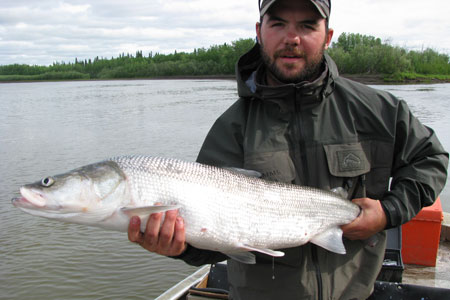
In late summer 2007, I began what turned into a 13-year study of sheefish in the Kuskokwim River. Radiotelemetry techniques were used between 2007-2016 to expand our knowledge of spawning locations, migration timing, and seasonal distributions and movements of sheefish. Taking what we learned from the radiotelemetry project, my colleagues and I then used sonar to count post-spawning sheefish as they outmigrated from the Big River, the most populous spawning location, during 2016-2018.
The Kuskokwim River drains a region the size of the state of Louisiana, about 130,000 km2 along a 1,130 km course from its Alaska Range headwaters to the Bering Sea. Being the second largest drainage in Alaska, the Kuskokwim River has numerous villages, homesteads, and fish camps located along its length. Local residents depend on fish and wildlife resources in this drainage and sheefish are a prized subsistence food. They are also valued by sport fishers due to their size and fighting spirit when hooked.
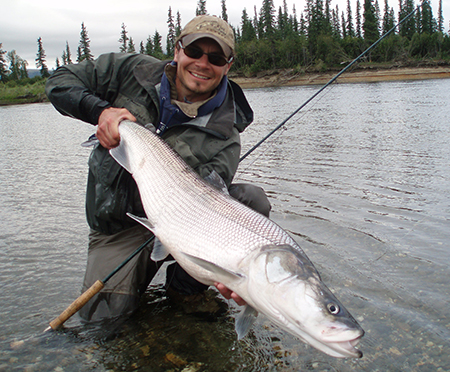
Sheefish are the largest members of the whitefish family and are found in the Kuskokwim, Yukon, Selawik, and Kobuk Rivers in Alaska. Elsewhere they are called “Inconnu” and are found in northwestern Canadian drainages like the Anderson and Mackenzie rivers and in Eurasia range westward across Siberia to the White Sea and south to Kamchatka. Sheefish are distinguishable by a relatively large size compared to other whitefish in Alaska and a strong, extended lower jaw. Most sheefish in the Yukon and Kuskokwim rivers have been noted to migrate long distances from the upper reaches of the drainages down to the bays and ocean. Sheefish can live 20-30 years, with the oldest in this study aged at 26 years. Overall, Kuskokwim River sheefish do not get as large as those seen in the Kobuk and Selawik rivers and parts of the Yukon River, which can reach 50 to 60 pounds. However, in my opinion, what they may lack in size, they more than make up in having a very interesting life history.
We captured nearly 200 fish in various locations from the lower to the upper Kuskokwim River from spring to fall during 2007-2014, and surgically implanted radio transmitters that emitted a unique code and transmitted for three to six years. We primarily used hook and line gear to capture sheefish where water was clear enough for this visual predator to see the lures. I found the best lures were those that mimicked prey like juvenile salmon and smelt, such as shiny spoons. Where water was occluded, we used set gillnets. The radiotagged fish were then tracked using a series of stationary tracking stations, which housed radio receivers that recorded the time and date whenever a fish swam by and were powered by solar panels and rechargeable batteries. The radiotagged sheefish were tracked using a small airplane with antennas attached to the wing struts during June and July when sheefish were actively feeding and during the late September-early October spawning time.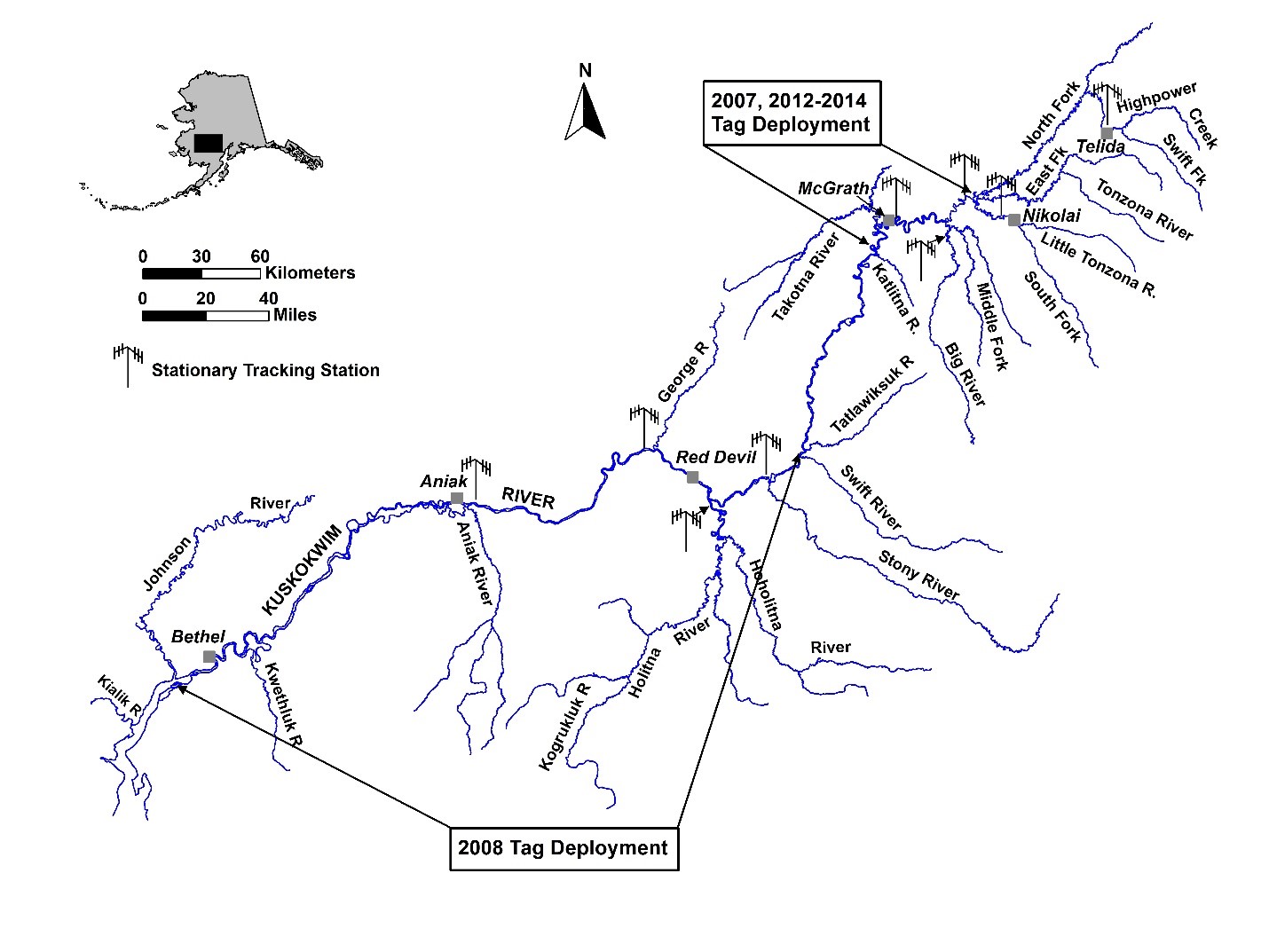
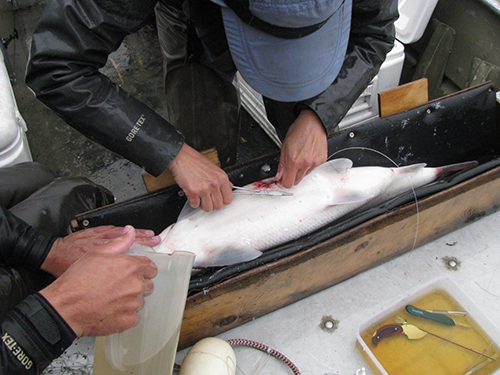
This study showed that most of the radiotagged sheefish spent their winters in the lower river in brackish water. However, approximately 15 percent overwintered in the mainstem Kuskokwim River as far upriver as Medfra and in the lower Holitna River or overwintered in the middle to upper mainstem for a few years and then overwintered in the lower river and vice versa. Back in the 1970’s ADF&G fishery biologist, Ken Alt, noted a fish he tagged on the Holitna River ended up in the middle-Yukon River! Sheefish life history can be very unpredictable and working with them all of these years was never boring.
During early spring, after ice-out, most sheefish traveled to the mouths of major drainages to feast on outmigrating juvenile salmon. Many headed to the Holitna River, which is located in the middle Kuskokwim River, a beautiful river that is an important spawning area for all five Pacific salmon. So, to a sheefish the Holitna River is a grand feast! I’ve captured fish with stomachs full of juvenile salmon on the lower Holitna River during mid-late June. Some sheefish remained in the lower Kuskokwim River and feasted on immigrating rainbow smelt. Later in the fall, I captured sheefish on the Holitna River with stomachs full of juvenile whitefish, and sheefish I netted below Bethel had stomachs full of three and nine-spine stickleback. I’ve also captured sheefish in mid-September on the East Fork Kuskokwim that had stomachs full of juvenile northern pike. I definitely have one thing in common with this species, we both like to eat! Many sheefish showed fidelity to their summer feeding areas, while others would swim the drainage and visit different tributary mouths.
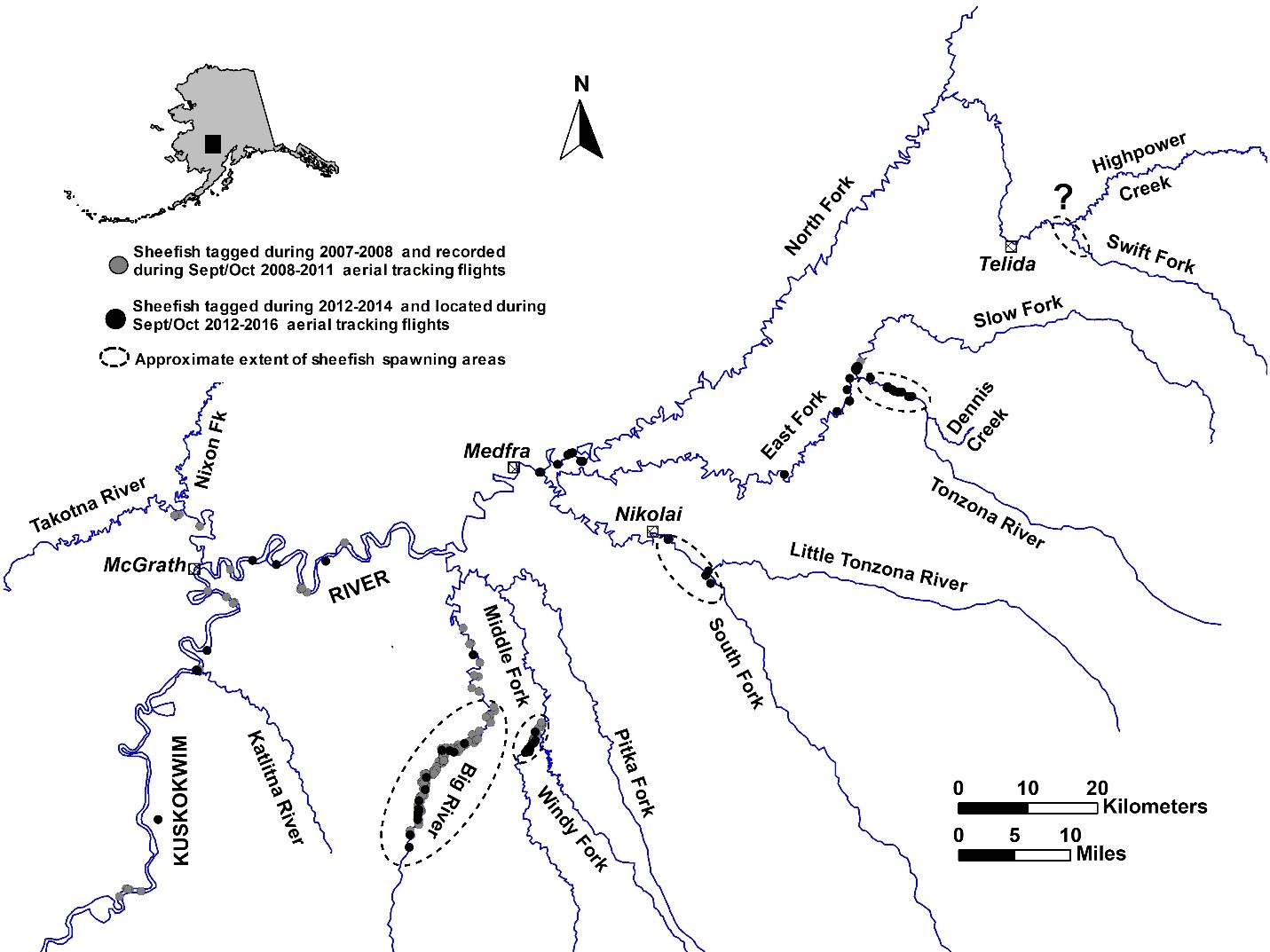 After a summer of feeding, sheefish travel to fall spawning locations. Sheefish tend to spawn in very few and relatively small areas. Radiotagged sheefish were tracked to four of five known spawning areas in the upper Kuskokwim River: Big and Tonzona rivers and the Middle and South forks. Sixty percent traveled to a 13-mile section of the Big River, a well-known spawning location where upriver residents often harvest sheefish in the fall at the mouth. The upper Athabascan place name for the Big River is “Zidlaghe Zighashno,” which translates to “sheefish harvest river.” None of the radiotagged sheefish traveled to a documented spawning location on the Swift Fork Kuskokwim River near Highpower Creek. Here, we made three trips during the time of spawning and tried to capture sheefish with nets and hook and line gear and were unsuccessful. According to upper Kuskokwim River residents, sheefish have not been seen here since the 1990s and therefore this may no longer be a viable spawning area. Given they spawn in so few areas, losing one or more in a drainage is concerning and shows the importance of protecting and preserving the other spawning locations.
After a summer of feeding, sheefish travel to fall spawning locations. Sheefish tend to spawn in very few and relatively small areas. Radiotagged sheefish were tracked to four of five known spawning areas in the upper Kuskokwim River: Big and Tonzona rivers and the Middle and South forks. Sixty percent traveled to a 13-mile section of the Big River, a well-known spawning location where upriver residents often harvest sheefish in the fall at the mouth. The upper Athabascan place name for the Big River is “Zidlaghe Zighashno,” which translates to “sheefish harvest river.” None of the radiotagged sheefish traveled to a documented spawning location on the Swift Fork Kuskokwim River near Highpower Creek. Here, we made three trips during the time of spawning and tried to capture sheefish with nets and hook and line gear and were unsuccessful. According to upper Kuskokwim River residents, sheefish have not been seen here since the 1990s and therefore this may no longer be a viable spawning area. Given they spawn in so few areas, losing one or more in a drainage is concerning and shows the importance of protecting and preserving the other spawning locations.
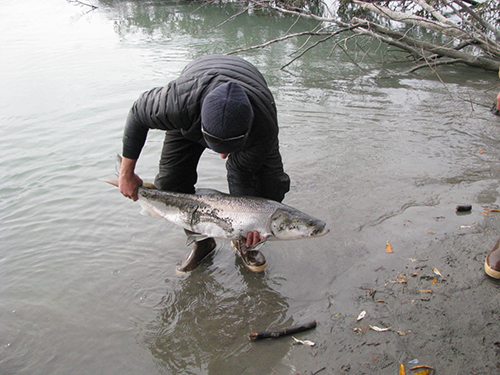
Sheefish spawn during a relatively short period in late September and early October, one of the few times their behavior can be predicted! It might take them up to two months to arrive at their spawning locations. As broadcast spawners that release eggs and milt into the open water, it is okay to arrive early, but you don’t want to be late! After spawning and as water temperatures near freezing, the post-spawning sheefish will leave fairly quickly in about 1 to 1.5 weeks. Not all of the radiotagged sheefish spawned every year, with most skipping one or more. Most spawning sheefish returned to the same spawning area. Not surprising, there were exceptions!
During late summer, the upper Kuskokwim River sheefish spawning areas were visited to record spawning habitat characteristics. Spawning locations in the Kuskokwim River are glacially influenced. Conductivity was above 350 µS/cm, pH ranged between 8.1 and 8.3, dissolved oxygen was high (~90 percent) and because they spawn during late September and early October, water temperatures ranged from near 0oC to 4oC for the duration of the spawning period. Substrate at the spawning locations was characterized with differentially sized gravel and cobble with sand and silt filling the interstitials, perfect substrate to capture sinking fertilized eggs. These characteristics have been noted in other sheefish spawning areas in Alaska and Canada.
During initial tagging and while visiting sheefish spawning locations, sheefish were captured and fin clips collected for a statewide genetics study. Although spawning, feeding, and overwintering behaviors of individual sheefish could be predictable from year to year or variable, it turns out, Kuskokwim River sheefish belong to a single genetic stock. This is not too surprising considering they spawn in very few and relatively small tributary stretches and as broadcast spawners, eggs and milt of the sheefish with these varying life-history strategies will intermingle.
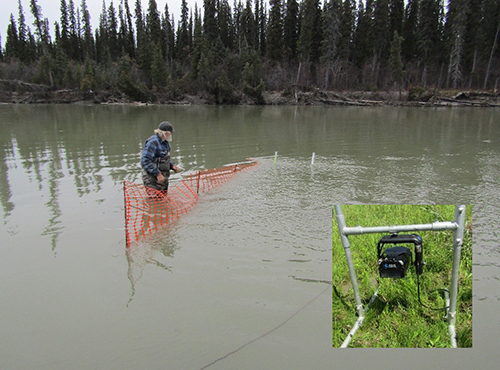
After all that was learned from the radiotelemetry study, the next step was to try and figure out the population in the Kuskokwim River. Because of their unpredictable life history strategies, the best way to get an idea was to place an ARIS (Adaptive Resolution Imaging Sonar) at the mouth of the Big River and count the post-spawning sheefish during their rapid outmigration. During 2016, we ran the sonar until river ice forced us to remove it and deconstruct camp on October 15th. Prior to removal we counted 5,334 fish. The ARIS software takes the images from the three-dimensional sonar and makes it into 2D images. So, floating ice can mimic a fish, plus can damage the sonar in addition to stranding the sonar crew. The following year, unseasonal flooding in mid-October forced us to end counting on October 11th. For 2017 we counted 2,635 prior to the flooding, which represented a minimum estimate. For 2018, the Big River didn’t freeze up until October 24th, and we had a fairly complete count of 6,799 sheefish. Because sheefish can skip one or mor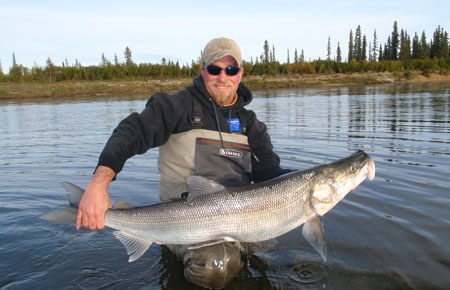 e years between spawning events, chances are this number will change based on the year. A sister study conducted on the Kobuk River estimated that each year approximately 30 percent of sheefish spawned, which I think would be applicable here too.
e years between spawning events, chances are this number will change based on the year. A sister study conducted on the Kobuk River estimated that each year approximately 30 percent of sheefish spawned, which I think would be applicable here too.
Enjoy catching sheefish and they are good to eat, but please take care to not cause undo mortality when sport fishing. We want this fascinating and popular sport and subsistence resource to be around in good numbers in the future. A very good pamphlet entitled “Sheefish Catch and Release” can be found at:
https://www.adfg.alaska.gov/index.cfm?adfg=fishingSportFishingInfo.InteriorPublications
Please familiarize yourself with landing and releasing techniques before you go fishing. Also, always have a fishing license and know the daily bag and possession limits for the location(s) where you will be fishing.
More on sheefish: The Tarpon of the North: Kobuk River Sheefish
Lisa Stuby is the current Yukon River Area Management biologist for Division of Sport Fish in Fairbanks. Previously she worked as a research biologist during 1995-2018 and spent 17 of those years working on sheefish and Chinook salmon radiotelemetry and sonar projects in the Kuskokwim River. Her office in Fairbanks is covered with fish art.
Subscribe to be notified about new issues
Receive a monthly notice about new issues and articles.
